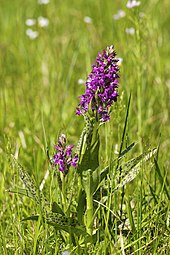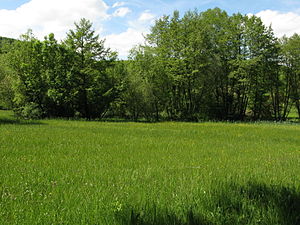Erletal
|
Erletal nature reserve
|
||
|
Erletal nature reserve |
||
| location | Endingen , Emmendingen district , Baden-Württemberg , Germany | |
| surface | 2,331 ha | |
| Identifier | 3,180 | |
| WDPA ID | 162998 | |
| Geographical location | 48 ° 8 ' N , 7 ° 42' E | |
|
|
||
| Sea level | from 220 m to 250 m | |
| Setup date | May 10, 1991 | |
| administration | Regional council Freiburg | |
The Erletal lies in the area of the town of Endingen in the district of Emmendingen in Baden-Württemberg . A small part of the valley is also a nature reserve of the same name in the Kaiserstuhl natural area .
geography

The Erletal is located in the northeastern Kaiserstuhl near Endingen . It leads south from the city up to the Katharinenberg ( 492.4 m above sea level ). To the west of the valley is the Nahe valley, which leads to the Amolterer Heide . On the southern edge and between these valleys, on the foothills of the Katharinenberg, small remains of the Koliburg wall can be discovered at a good 360 m .
At the southern exit of Endingen is the Erleweiher, a natural pond (approx. 60 × 60 m) with a bathing area, a non-swimmer area and various sports facilities.
From the rental company, an avenue of more than 100 chestnuts stretches along a few other sports fields through the valley to the nature reserve, which is about 1.7 kilometers from the city center.
Erl hole
The Erleloch, near the protected area and before the ascent to the Katharinenberg, is a 100 meter long tunnel and former drinking water canal and leads from the Erletal east through the Brüstleberg into the parallel Riedbach valley. When the supply of drinking water to the city of Endingen from the springs in the Erletal was no longer sufficient, this channel was dug in 1788 so that springs from the Riedbach valley could be used. The tunnel is lined with red sandstone at the entrance and exit and fixed with stones inside. The almost head-high tunnel can be entered today.
Nature reserve
Characteristics

The nature reserve was designated by ordinance on May 10, 1991 by the Freiburg Regional Council and has an area of 2.3 hectares. It is listed under the protected area number 3.180 and is classified in IUCN Category IV, a biotope and species protection area. The CDDA code is 162998 and also corresponds to the WDPA ID .
Protection purpose
The protection purpose "is the preservation of a wetland as a habitat for several rare and endangered plant communities with numerous threatened plant species."
Geology and development
In this basin, the loess that was blown up during the ice ages led to an accumulation of the clayey components and thus the development of a densely layered and less impermeable layer, which results in a continuous damming of the water by precipitation. This favored the emergence of forests with black alder and larger wetlands such as wet meadows . With expansion of settlement areas and intensification of agriculture since the 1950s, in the adjacent valleys, such as. B. in the Riedbachtal, the last remaining wetlands in the Kaiserstuhl drained and destroyed.
Flora and fauna
The protected area, mostly surrounded by forest and vines, with its wet meadows in the Kaiserstuhl is the last remaining area of its kind. It is home to numerous protected animal and plant species. In the area there is a small-scale mosaic of wetlands and will dry meadows , wet meadows , small sedge vineyards and large sedge vineyards , reed beds , Hochstaudenfluren , riparian woodland and stream vegetation.

At this point in the Kaiserstuhl is the only Davall-Sedge spring moor ( Caricetum davallianae ). It is formed from the eponymous Davalls sedge . The Davalls Sedge reaches heights of between 10 and 25 centimeters. The company includes among other things, on the Red List standing Broad cotton grass . Both plants are threatened with extinction in the Rhine valley and in the Kaiserstuhl.
The mown meadows show an extraordinarily high occurrence of various orchids . B. the richness of the broad-leaved orchid and the marsh stendrums . Also represented are the otherwise seldom found great meadow button in the Kaiserstuhl , the cabbage thistle and the forest angelica . Furthermore, can be found here also endangered in Germany Fringed Pink .
In the semi-dry grasslands that grow upright brome , the Vetch , the Spiny Restharrow and from the family of the orchids of Hundswurz . Another orchid, the mosquito-handelwort , also thrives in more humid locations, as does the blue-green sedge from the sourgrass family .
On the meadows that are not or only irregularly mowed, the common yellow loosestrife , the giant goldenrod and the water dost can be found in the tall herbaceous meadows from the series of rather tall plants .

In connection with its surroundings , the nature reserve is a biotope for numerous birds, the oriole and the turtledove are frequent guests. Find their living space here z. As the from the family of finches originating Stieglitz , the Linnet and European Serin . The marsh insect is represented as it prefers wet and wet meadows. Butterflies find their important feeding habitat in the perennial corridors .
hike
The Neunlindenpfad (north-south path), a classic hiking trail in the Kaiserstuhl, and the Kaiserstuhlpfad, a certified hiking trail , lead from Ihringen to Endingen through the Erletal.
See also
- List of nature reserves in Baden-Württemberg
- List of nature reserves in the district of Emmendingen
- List of natural spatial units in Baden-Württemberg
Individual evidence
- ↑ Profile of the nature reserve in the LUBW's list of protected areas
- ↑ Map services of the Federal Agency for Nature Conservation ( information )
- ↑ § 3 Protection Ordinance of the Freiburg Regional Council of May 10, 1991, accessed on March 26, 2013
- ^ Department for nature conservation and landscape management: nature reserves in the administrative district of Freiburg . Ed .: Regional Council Freiburg. 3. Edition. Thorbecke, Ostfildern 2011, ISBN 978-3-7995-5177-9 , pp. 274-275 .
literature
- Nature Conservation and Landscape Management Unit: Nature reserves in the Freiburg administrative region . Ed .: Regional Council Freiburg. 3. Edition. Thorbecke, Ostfildern 2011, ISBN 978-3-7995-5177-9 .
Web links
- Profile of the nature reserve in the LUBW's list of protected areas
- Erletal, Erleweiher and Erleloch on mitwelt.org




